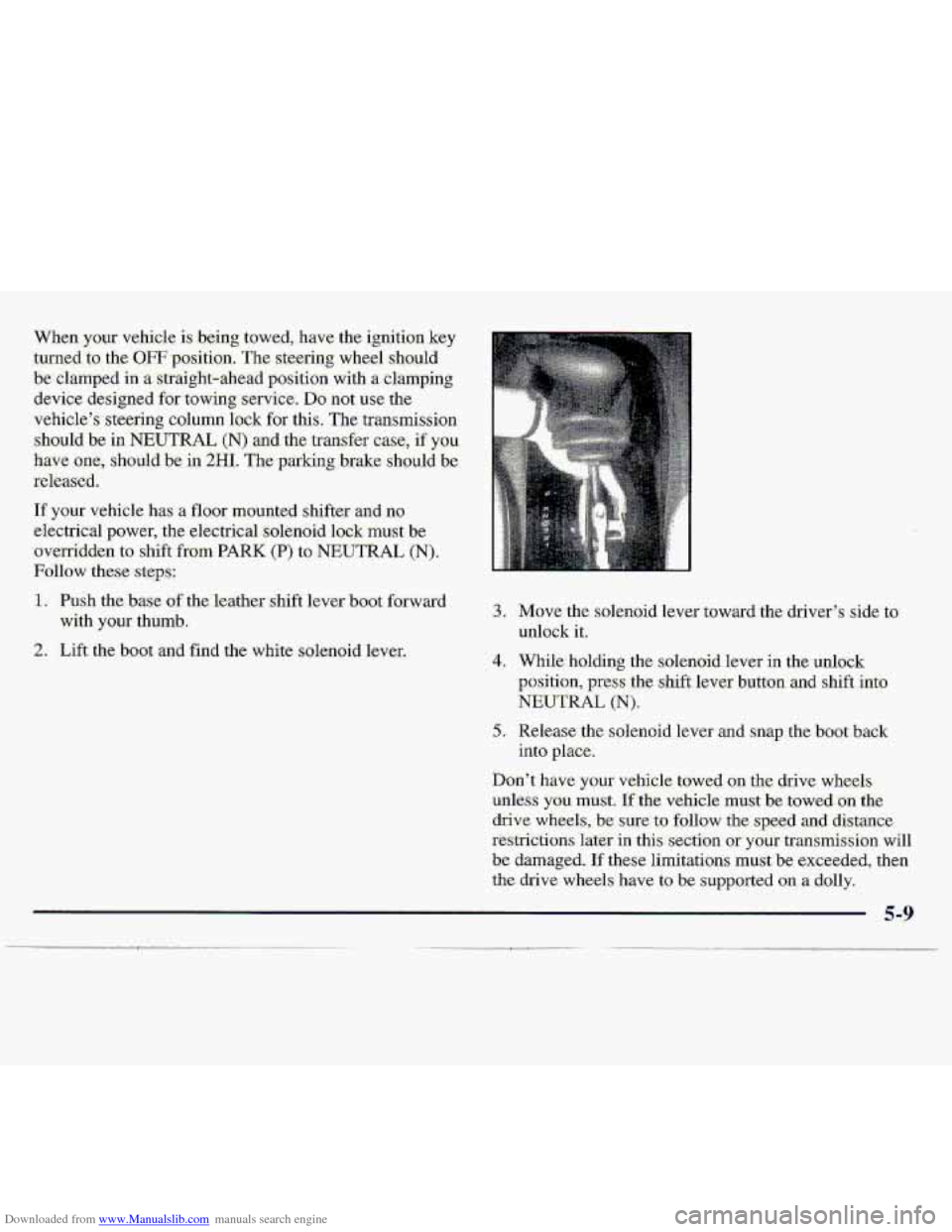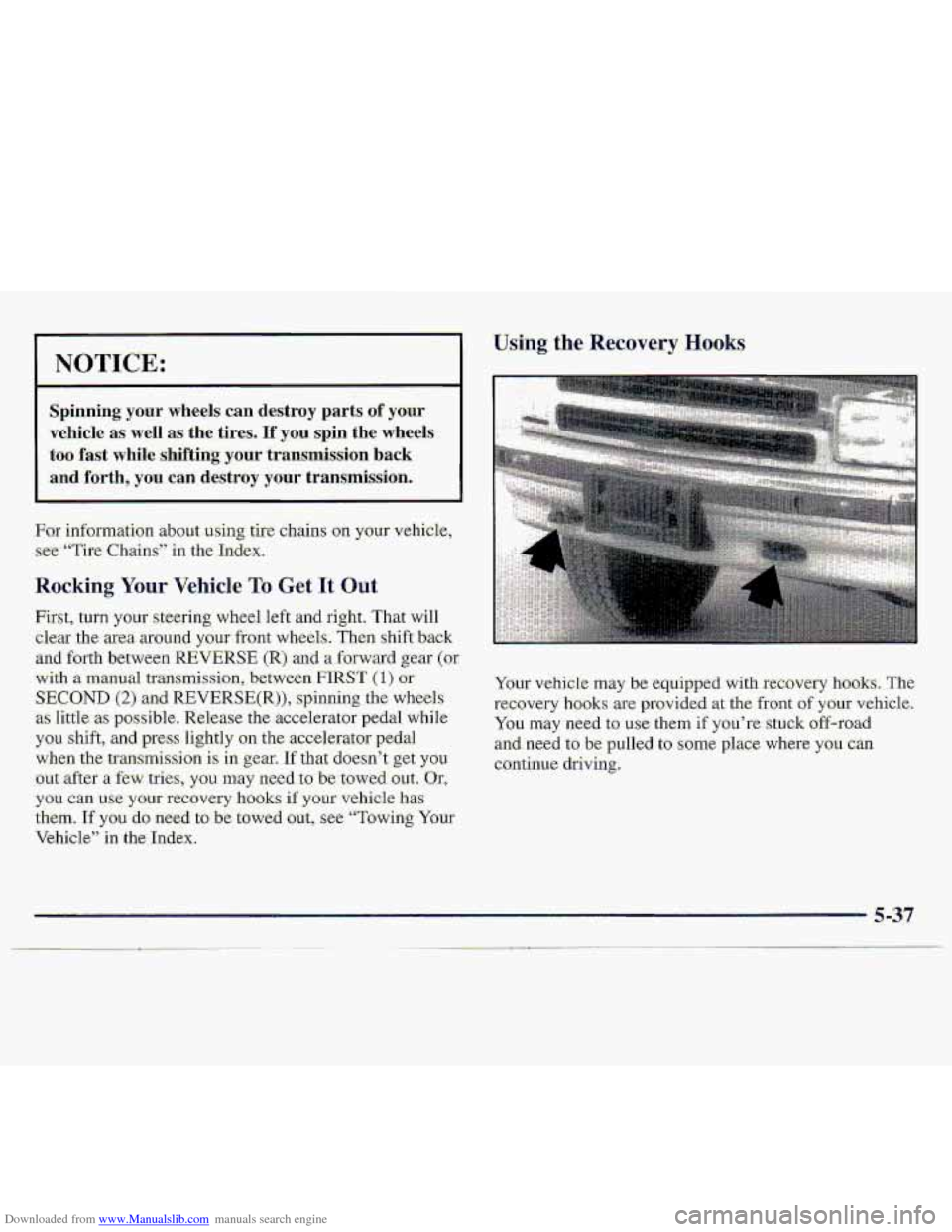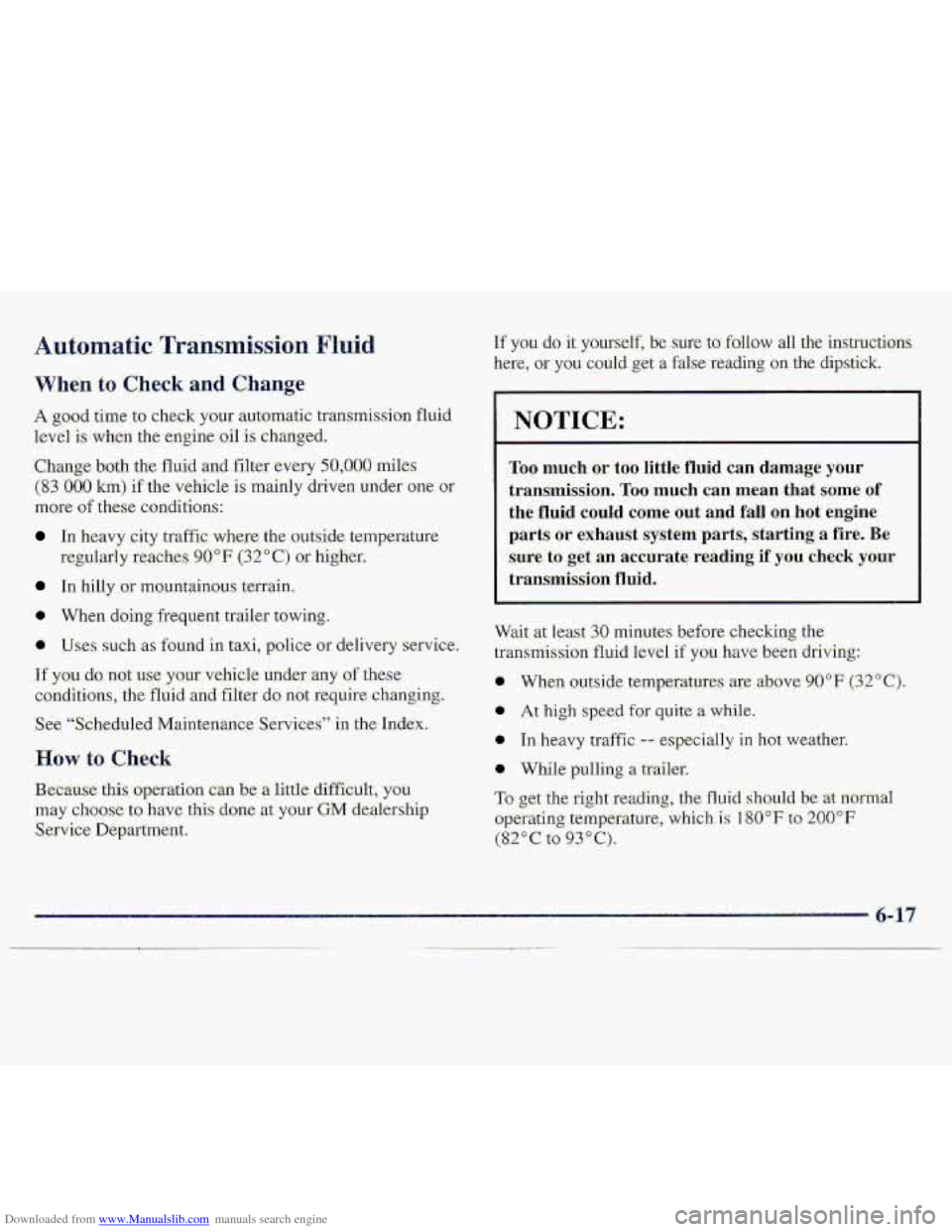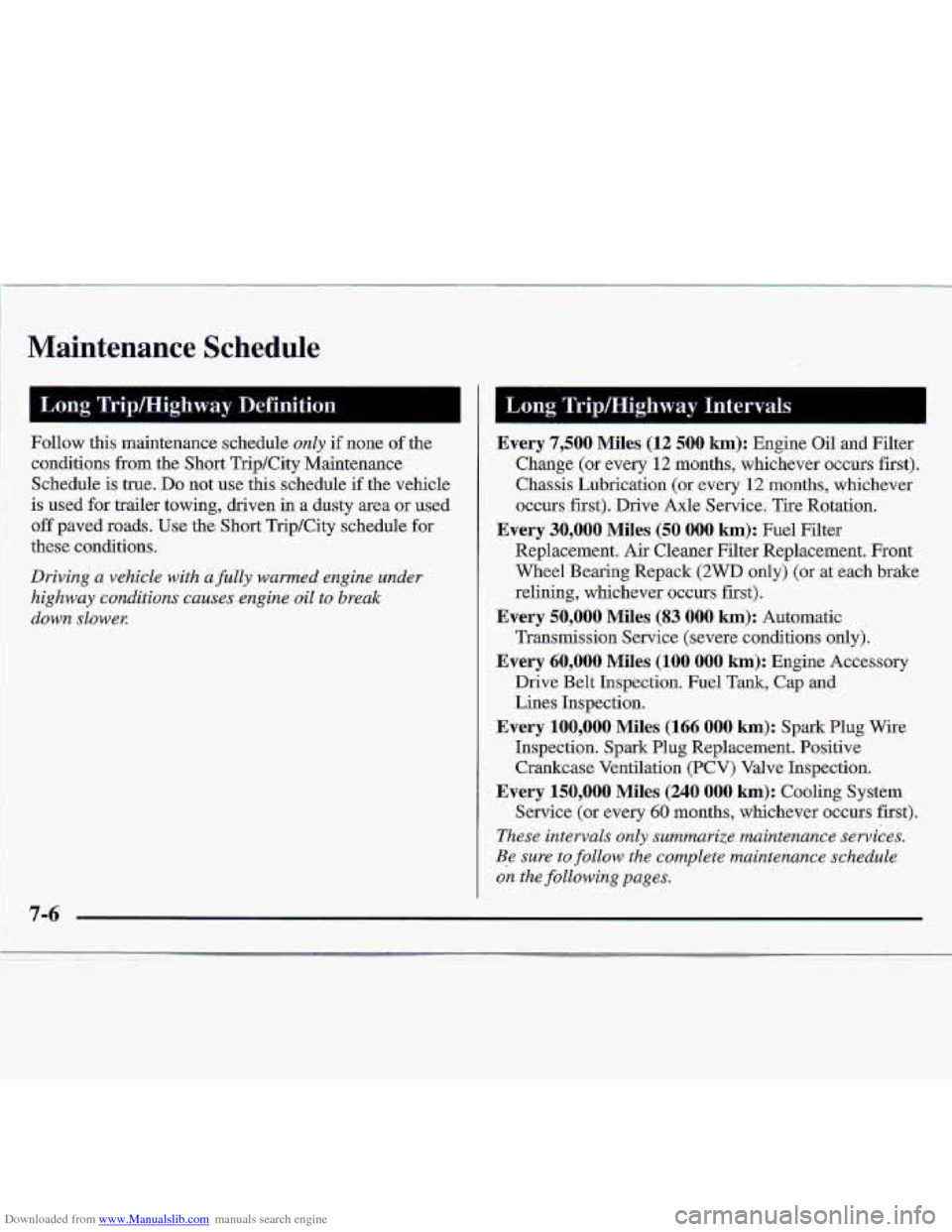Page 198 of 402
Downloaded from www.Manualslib.com manuals search engine Section 5 Problems on the Road
Here you'll:find.what ta do about some problems .that ciin "Ciel%af bfi the road.
5- 2 Hazard. Warning Flaihers.
5-2 .Other Warning Devices
5-3 Jump Starting
5-7 Towing Your Vehicle
5-1 2 Engine Overhearing
5-22
5-22
5-23
5-35
5-36
Engine Fan Noise
Ita Tife Goes Flat
Changirig
x Flat 'Tire
Compact Spare Tire (Tf Equipped)
If You're Stuck: In Sand, Mud,
Ice or Snow
Page 205 of 402
Downloaded from www.Manualslib.com manuals search engine I
TO hdp avoid injury to you or! otfiws:
* Never let passengers ride in a vehicle that is
@ Never tow faster than safe or posted speeds.
0 Never taw "wish d.amage.d piarts not
0 Never.@ under your vehicle after it has
being towed.
fully secured,
been.
I[i€ted by the tow truck.
Always we s,eparate safety chains..on each
.side -when towing a vehicle.
0 Newr use J-hooks. Use T-hooks instead.
A vehicle can fall from a car carrier .i it isn't
adequately secured.
This can cause a .:collision9
serious personal injury and vehicle damage. The
vehicle
shouid.be tightly secured with chains or
steel cables before
it is transported.
Dan% use substitutes (ropes, leather-straps,
canvas webbing, etc.) that can be cut by sharp
edges. underneath thedowed vehicle. Always use
T-hooks inserted in the T=hook slots, Never use
J-hooks. They will damage .drivetrain *and
suspension components.
Page 206 of 402

Downloaded from www.Manualslib.com manuals search engine When your vehicle is being towed,. h-ave the ignition key
. md.& ;the OFF- position.. The ite,erin,g wliegl sli~ultl
be. cla-mped in- a straightdahezd position witb a clamping
&vice desi:ped for towing-service. DO fiat ust the
vehicle's steering c.olumxz I-ock for this. The transmission
should be in
NEUTRAL (N) an-d the .transfer case, if you
'31ave one, ShQuLd. be in 2HI. The p&ing.bm.ke shguld-.-lje
seleased.
If your vehicle has. a flqor mounted shifter and no
.electrical power,
the electrical.So1enoi.d lock must be
.ovexKidd.m tu shi%t-.hm PARK (P> :to NEUTRAL (Nj.
Follow -:these. step.8:
1. Push the'bme of the.'€e.ather shift leva boat forward
with
your thumb.
L
3.
4.
5'.
'Move the solenoid. lever toward the driver's side to.
m1oc.k it;
'While holding the solenoid lever in the unlock
gosition, press the shift lever button and shift into
NEUTRAL
(N).
Release the solenoid lever and snap the b.QgL.b.a&
into place.
,... . .
Don't have your vehi-cle towed on th-e drive wheels
unless you must. If -the Vehicle .must be towed--on. the
drive wheels, be sure to follow the. sp.e.ad and distance
restrictions
Mer in this section oryour transmission will
be damaged.. If these limitations must be exceeded, the0
the drive wheels have to b:e supported on .a dolly.
Page 207 of 402
Downloaded from www.Manualslib.com manuals search engine Front Towing;
Tow.Limits. -- 35 rnph (56 kmh), 50 miles (-8O-km)
lrehicles with fuur-whesl-drive with the electronic
-transfercase opth must use a towing dolly under the
mar whe& when towing from the fipnt.
NOTICE:
Do not tow with sling-type equipment or
fascia/fog lamp damage will occur. Use wheel-lift
or car-carrier equipment. Additional ramping
may be. fequiped for car-earrier equipment.
Uk
safety chains and wheel straps.
Towing a vehicle over rough surfaces could
damage
a vehicle. Damage can occur from
vehicle to
ground or vehicle to wheel-lift
equipment.
To help avoid damage, instan a
towing doIly and raise the vehicle until adequate
clearance is obtained between the-ground and/or
wheel-lift equipment.
Do
not attach winch cables or J-haoks to
suspension components. when using;car-carrier
eq-uipment. Always use
T-hooks inserted in
the
T-hook-slots.
Page 208 of 402
Downloaded from www.Manualslib.com manuals search engine Rear Towing
Tow Limits -- .35 mph (56 kwdh), 50 miles (SO kmj
Vehicles with four-whe&dvive with EkctroHic transfer
case option must use a towing, dolly under th.efron;t
~vheels when towing- frmn the reaz
NOTICE:
Do not tow with sling-type equipment or rear
bumper valance damage will occur. Use wheel-lift ,
or car-carrier equipment. Additional rainping
may
be required for car carrier equipment. Use
safety chains
and wheel straps.
Towing
a vehicle over rough Surfaces could
damage a vehicle. Damage
can occur from
vehicle to .ground
or vehicle to wheel-lift
eq-uipment.
Ta help avoid darnage, install a
towing dally and raise the vehicle until adequate
clearance is obtained between the
ground and/or
wheel-lift equipment.
Do not ,attach winch cables or J-hooks ta
suspension components when using car-carrier
equipment.
Always use- T-hooks inserted in
the
T-hook slots.
5-11
Page 234 of 402

Downloaded from www.Manualslib.com manuals search engine NOTICE:
Spinning your wheels can destroy parts of your
vehicle as we11 as the tires. If you spin the wheels
too fast while shifting your transmission back
and forth, you can destroy your- transmission.
For information about using tire chains on your vehicle,
see “Tire Chains” in the Index.
Rocking Your Vehicle To Get It Out
First, turn your steering wheel left and right. That will
;clear the area around your front wheels. Then
shift back
,;and forth between REVERSE (R) and a forward gear (or
*with
a manual transmission, between FIRST (1) or
SECOND (2) and REVERSE(R)), spinning the wheels
as little
as possible. Release the accelerator pedal while
you shift, and press lightly on the accelerator pedal
when the transmission is in g,ear. If that doesn’t get
you
out after a few tries,. you may need to be towed out. Or,
you c.an use.your recovery hooks if your vehicle. has
::them. IT you do need
to be tawed out, see “Towing Your
”Vehicle” in the
Index,.
U-sing the Recovery Hooks
Tour vihilfe may be equipped with recovery hooks. The
recovery
hooks are pmvided at the front of yo-ur vehicle.
You may need to use them if you’re stuck off-road
and need to be pulled to some place where you can
wntinue driving.
5-37
____
Page 254 of 402

Downloaded from www.Manualslib.com manuals search engine When to Check and Change
.A goad time to check-your a0tomati.c transmission fluid
level is when the en.gine .oil is chanzed,
C.hange
both the fluid an.d filter every 50,000-miles
(8'3 000 km) if the vehicle is mainly driven under one or
more of these conditions:
In heavy city traf€ic where the-outsi.de. temperature
regularly reaches.
906F (.32'C) or higher.
In hilly or mountainom terrain.
0 When doing frequent trailer towing.
0 Uses. such as found in taxi, police or delivery service.
If
you do not use your vehicle under any of the-se
cqnditions, the fluid and filter do not require changing.
See "Scheduled Maintenance Services"
in the Index,
How to Check
B.eCanse this operation can be a little difficult, you
may cho.Oge to have this dme at your GM de-alership
Service
Department
If you do it ywrsiAf, be sure to follow all the instruaims
here, uryclu coukd get a false re.adirig on the dipstick.
NOTICE:
Too much or too little fluid can damage- your
transmission,
TQO much can mean that s.ome of
the fluid could come out and fall on hot engine
parts or exhaust system parts, starting a fire. Be
sure to getan accurate reading if .you .check .your
transmission fluid.
Wait &t least.30 minutes before checking the
transmissioil fluid
level if.you have been driving:
* When ou&ide te:mperatures ar~ above 9C>-'F (32 O C).
0 At high spe>ed fbr.quite-.a while.
0 Tn'heavy traffic -- especidly in hot weather.
While pulling
a. trailer:
To -get the right reading, the flui,d'should be at dermal
operating temperature, which- is 1:80."F to 208°F
(82QG to 33°C).
Page 315 of 402

Downloaded from www.Manualslib.com manuals search engine Maintenance Schedule
Follow this maintenance schedule only if none of the
conditions from the Short Trip/City Maintenance
Schedule is true.
Do not use this schedule if the vehicle
is used for trailer towing, driven in a dusty area or used
off paved roads. Use the Short Trip/City schedule for
these conditions.
Driving a vehicle with af.lly warmed engine under
highway conditions causes engine oil
to break
down slower,
~ - Long'T.l.ip/Hi-ghway Intervals
Every 7,500 Miles (12 500 km): Engine Oil and Filter
Change
(or every 12 months, whichever occurs first).
Chassis Lubrication (or every
12 months, whichever
occurs first). Drive Axle Service. Tire Rotation.
Replacement. Air Cleaner Filter Replacement. Front
Wheel Bearing Repack
(2WD only) (or at each brake
relining, whichever occurs first).
Transmission Service (severe conditions only).
Drive Belt Inspection. Fuel Tank, Cap and
Lines Inspection.
Inspection. Spark Plug Replacement. Positive Crankcase Ventilation (PCV) Valve Inspection.
Every 150,000 Miles (240 000 km): Cooling System
Service (or every
-60 months, whichever occurs first).
These intervals only summarize. maintenance services.
Be sure
to follow the complete maintenance schedule
on the following pages.
Every 30,000 Miles (50 000 km): Fuel Filter
Every 50,000 Miles (83 000 km): Automatic
Every 60,000 Miles (100 000 km): Engine Accessory
Every 100,000 Miles (166 000 km): Spark Plug Wire
7-6